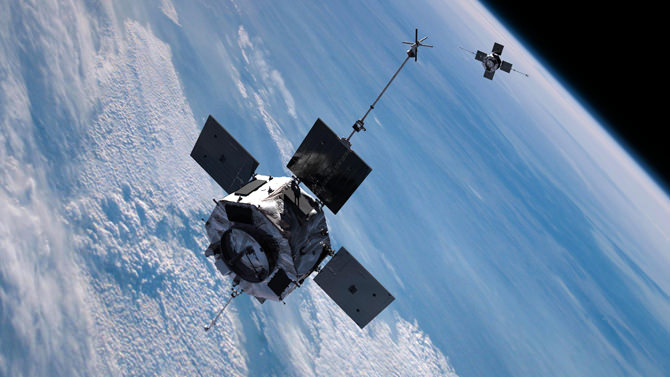[/caption]
During the 1950s and just before the great “Space Race” began, scientists like Kristian Birkeland, Carl Stormer, and Nicholas Christofilos had been paying close attention to a theory – one that involved trapped, charged particles in a ring around the Earth. This plasma donut held in place by our planet’s magnetic field was later confirmed by the first three Explorer missions under the direction of Dr. James Van Allen. Fueled by perhaps solar winds, or cosmic rays, the knowledge of their existence was the stuff of nightmares for an uniformed public. While the “radiation” can affect objects passing through it, it doesn’t reach Earth, and this realization quickly caused fears to die. However, there are still many unanswered questions about the Van Allen Radiation Belts that mystify modern science.
Over the years we’ve learned these radiation zones are comprised of electrons and energetically charged particles. We’ve documented the fact they can both shrink and swell according to the amount of solar energy they receive, but what researchers haven’t been able to pinpoint is exactly what causes these responses. Particles come and particles go – but there isn’t a solid answer without evidence. A pertinent question has been to determine if particles escape into interplanetary space when the belts shrink – or do they fall to Earth? Up until now, it’s been an enigma, but a new study employing several spacecraft at the same time has been to trace the particles and follow the trail up.
“For a long time, it was thought particles would precipitate downward out of the belts,” says Drew Turner, a scientist at the University of California, Los Angeles, and first author on a paper on these results appearing online in Nature Physics on January 29, 2012. “But more recently, researchers theorized that maybe particles could sweep outward. Our results for this event are clear: we saw no increase in downward precipitation.”
From October to December 2003, the radiation belts swelled and shrank in response to geomagnetic storms as particles entered and escaped the belts. Credit: NASA/Goddard Scientific Visualization Studio
This isn’t just a simple answer to simple question, though. Understanding the movement of the particles can play a critical role in protecting our satellite systems as they pass through the Van Allen Belts – and its far reaching radiation extensions. As we know, the Sun produces copious amounts of charged particles in the stellar winds and – at times – can blast in our direction during coronal mass ejections (CMEs) or shock fronts caused by fast solar winds overtaking slower winds called co-rotating interaction regions -CIRs). When directed our way, they disrupt Earth’s magnetosphere in an event known as a geomagnetic storm. During a “storm” the radiation belt particles have been known to decrease and empty the belt within hours… a depletion which can last for days. While this is documented, we simply don’t know the cause, much less what causes the particles to leave!
In order to get a firmer grip on what’s happening requires multiple spacecraft measuring the changes at multiple points at the same time. This allows scientists to determine if an action that happens in one place affects another elsewhere. While we look forward to the Radiation Belt Storm Probes (RBSP) mission results, it isn’t scheduled to launch until August 2012. In the interim, researchers have combined data from two widely separated spacecraft to get an early determination of what happens during a loss event.
“We are entering an era where multi-spacecraft are key,” says Vassilis Angelopoulos, a space scientist at UCLA, and the principal investigator for THEMIS and a coauthor on the paper. “Being able to unite a fleet of available resources into one study is becoming more of a necessity to turn a corner in our understanding of Earth’s environment.”
So where did this early support information come from? Fortunately the team was able to observe a small geomagnetic storm which occurred on January 6, 2011. By engaging the the three NASA THEMIS (Time History of Events and Macroscale Interactions during Substorms) spacecraft, two GOES (Geostationary Operational Environment Satellite), operated by the National Oceanic and Atmospheric Administration (NOAA), and six POES (Polar Operational Environmental Satellite), run jointly by NOAA, and the European Organization for the Exploitation of Meteorological Satellites (EUMETSAT) spacecraft, they were able to catch electrons moving close to the speed of light as they dropped out of the belt for over six hours. Orbiting Earth’s equatorial zones, the THEMIS and GOES spacecraft are just part of the team. The POES spacecraft passes through the radiation belts several times a day as it cruises at a lower altitude and near the poles. By combining data, the scientists were able to take several observational vantage points and proved – without a doubt – that the particles left the belt by way of space and did not return to Earth.
“This was a very simple storm,” says Turner. “It’s not an extreme case, so we think it’s probably pretty typical of what happens in general and ongoing results from concurrent statistical studies support this.”
During this time, the spacecraft also observed a low-density area of the Van Allen belts which appeared along the periphery and traveled inward. This appeared to be an indication the particles were outward bound. If this was a normal occurrence, it stands to reason that a type of “wave” must assist the motion, allowing the particles to reach the outer escape boundary. Discovering just what exactly triggers this escape mechanism will be one of the jobs for RBSP, says David Sibeck at NASA’s Goddard Space Flight Center in Greenbelt, Md., who is NASA’s mission scientist for RBSP and project scientist for THEMIS.
“This kind of research is a key to understanding, and eventually predicting, hazardous events in the Earth’s radiation belts,” says Sibeck. “It’s a great comprehensive example of what we can expect to see throughout the forthcoming RBSP mission.”
Original Story Source: NASA THEMIS News Release.

